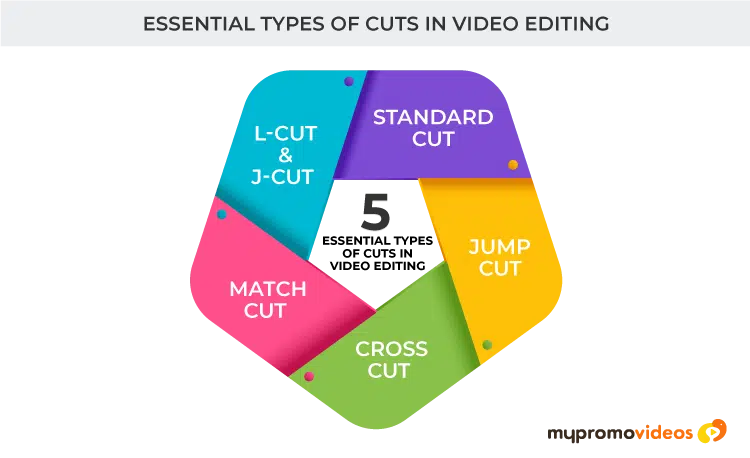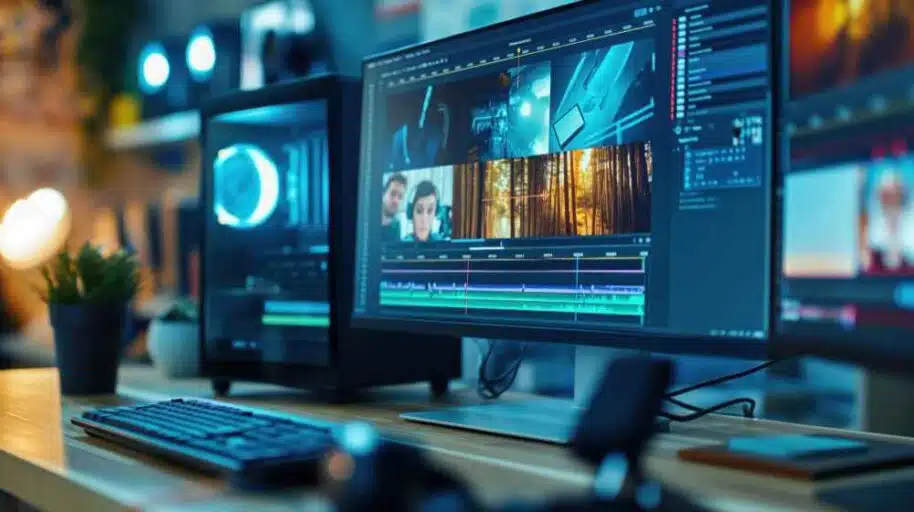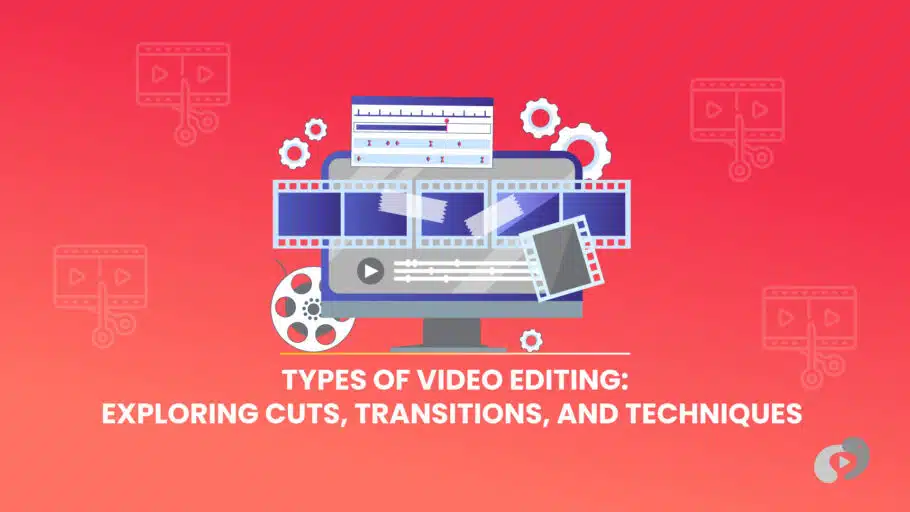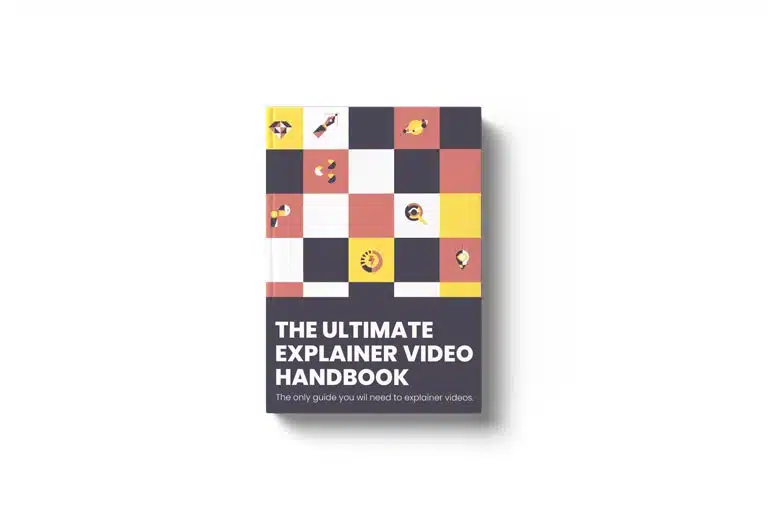Last Updated on August 28, 2024
Article Contents
Estimated reading time: 11 minutes
Understanding the Various Types of Video Editing
Video editing is a multifaceted art form that combines various techniques to create compelling and engaging content. Different approaches to video editing can dramatically influence the viewer’s experience and the effectiveness of the final product. Whether it’s a narrative film, a vlog, or a corporate video, the choice of editing style can set the tone, pace, and mood of the content.
Two fundamental concepts in video editing are cuts and transitions. A cut is an instantaneous change from one shot to another, which can help maintain the flow of the narrative or draw attention to specific details. Cuts are the most basic yet powerful tool in an editor’s arsenal, allowing for a seamless storytelling experience.
Transitions, on the other hand, involve the process of moving from one scene to another with a visual effect, such as a fade or a wipe. These are often used to signify a change in time, location, or mood, and can add a polished and professional touch to the video. Understanding and effectively utilizing cuts and transitions are pivotal in crafting videos that capture and hold the audience’s attention.
Types of Video Editing Techniques

Video editing techniques encompass a broad range of methods that can significantly enrich the storytelling process. By mastering different techniques, editors can enhance the visual appeal, emotional impact, and narrative coherence of their videos.
Linear Editing
Linear editing is a traditional video editing method that involves selecting and arranging video clips in a sequential order, typically on a videotape. This technique requires the editor to work in a step-by-step manner, making edits in the order they appear from start to finish. Once a change is made, going back and modifying earlier parts can be time-consuming. Despite its limitations, linear editing is valued for its simplicity and the discipline it instills in planning each edit carefully.
Non-Linear Editing (NLE)
Non-Linear Editing (NLE) revolutionized video production with its flexibility and efficiency. This digital editing method allows editors to access any frame in a video clip regardless of the sequence, making it easy to rearrange and modify segments without altering the original footage. NLE provides enhanced creative control, facilitating complex edits, effects, and transitions effortlessly. Popular NLE software includes Adobe Premiere Pro, Final Cut Pro, and Avid Media Composer, all of which offer a range of tools to optimize the editing workflow.
Industries we serve
Online Editing
Online editing is the final stage of video post-production, where the edited sequence is fine-tuned and polished for distribution. This process involves color correction, sound mixing, and adding visual effects to ensure the highest quality output. Unlike offline editing, online editing works with the highest resolution footage to maintain the integrity and clarity of the final product. By perfecting the technical details, online editing ensures that the video meets industry standards and looks impeccable on all viewing platforms.
Offline Editing
Offline editing is the preliminary phase in video post-production, where editors work with lower resolution copies of the original footage to create a rough cut. This method conserves computing resources and expedites the editing process. Once the rough cut is finalized, it is then conformed to the high-resolution footage during the online editing stage. This approach allows editors to experiment and refine their edits without worrying about technical constraints.
Bespoke Editing
Bespoke editing involves tailoring the editing process to meet the specific needs and preferences of the client or project. This bespoke approach allows for a more personalized touch, ensuring that the final video aligns perfectly with the vision and objectives of the stakeholders. It often includes unique transitions, custom graphics, and special effects, crafted specifically for the project. By focusing on individual requirements, bespoke editing creates a distinctive and memorable video that stands out from standard productions.
Live editing
Live editing involves making real-time edits during an event or broadcast, allowing for immediate adjustments and seamless integration of various media elements. This technique is often used in live sports, news broadcasts, and concerts, where the editing team needs to switch between camera angles, insert graphics, and manage audio levels on the fly. Efficiency and quick decision-making are crucial in live editing to ensure a flawless and engaging viewer experience. The ability to adapt swiftly to changing scenarios makes live editing a dynamic and challenging aspect of video production.
What are the essential types of cuts in video editing
Understanding the essential types of cuts in video editing is fundamental for any editor aiming to create a cohesive and engaging narrative. These types of cuts in video editing not only help in transitioning between scenes but also play a significant role in pacing and storytelling. Knowing when and how to use these them can greatly enhance the overall quality of the final production.

Standard Cut
The standard cut is the most basic and commonly used type of cut in video editing. It involves a straightforward transition from one clip to the next, without any special effects or transitions. This cut is ideal for maintaining the narrative flow and ensuring a seamless progression of scenes. By simply cutting from one shot to another, the standard cut keeps the audience’s attention on the story, making it an essential tool for any editor.
Jump Cut
A jump cut is a type of edit that involves an abrupt transition between two sequential shots that vary only slightly in angle or composition. This technique creates a jarring effect, drawing attention to the passage of time or emphasizing a particular segment of action. Jump cuts are often used in vlogs, interviews, or to add a dynamic flair to fast-paced sequences. While they can disrupt the smooth flow of a narrative, when used intentionally, jump cuts can effectively highlight changes, speed up the story, or convey a sense of urgency.
Cross Cut (Parallel Editing)
Cross-cutting, also known as parallel editing, is a technique used to depict two or more actions happening simultaneously in different locations. By alternating between the scenes, this method builds suspense and draws connections between the narratives occurring at the same time. Cross-cutting keeps the audience engaged by creating a sense of urgency and can enhance the storytelling by highlighting contrasts or similarities between the concurrent events.
Match Cut
A match cut is an editing technique where two visually similar shots are juxtaposed, creating a seamless transition that links two different scenes or actions. This can be achieved through matching shapes, colors, or thematic elements. Match cuts maintain the aesthetic continuity and can serve to indicate a connection or smooth out a potentially jarring scene transition. This method not only enhances the visual flow but also aids in storytelling by subtly guiding the audience’s attention.
L-Cut and J-Cut
L-Cuts and J-Cuts are techniques that play with the audio-visual elements to create a natural flow between scenes. An L-Cut occurs when the audio from the current scene continues to play over the beginning of the next scene, thus extending the audio “tail” into the new visual. Conversely, a J-Cut starts the audio from the upcoming scene while the visual from the current scene is still being shown, leading the audio “head” into the existing shot. These methods help bridge scenes smoothly, facilitating transitions and maintaining storytelling rhythm.
What are the types of transitions in video editing?
In video editing, transitions play a crucial role in connecting scenes and ensuring a cohesive narrative flow. Different types of transitions can evoke various emotions, set the pace, and create an engaging viewing experience. Below, we explore what are the types of video editing transitions most commonly used and their distinctive effects.
Standard Transition
A standard transition in video editing is the typical cut where one shot directly follows another without any added effect. This method maintains continuity, ensuring that the narrative progresses naturally and fluidly from one scene to the next. It is the most basic yet effective form of transition, often used to maintain a straightforward flow in storytelling. The simplicity of standard transitions ensures they do not distract the audience, keeping the focus on the content itself.
Fade In/Fade Out
Fade In and Fade Out transitions are used to gradually ease the viewer into or out of a scene. A Fade In transition slowly brings the image from black (or another color) to full visibility, often used at the beginning of a video or segment. Conversely, a Fade Out transition gradually diminishes the image into darkness, typically marking the end of a scene or piece of content. These techniques create a smooth and gentle visual experience, which can evoke emotion and signify the passage of time.
Dissolve (Crossfade)
A dissolve, also known as a crossfade, smoothens the transition between two scenes by overlapping the end of one shot with the beginning of the next. This creates a blending effect, where the first image gradually fades out as the second image simultaneously fades in. Dissolves are often used to signify a change in time or location, or to convey a connection between scenes. This technique provides a seamless and visually pleasing transition that helps maintain the narrative flow.
Wipe
A wipe transition involves one shot being progressively replaced by another shot in a distinct direction or shape, such as a vertical line or a clock hand. This technique visually “wipes” the first image off the screen, revealing the next scene beneath it. Wipes can be used to suggest a dynamic change in time or setting, or to introduce a new narrative thread. They are often employed in more stylized or genre-specific contexts to add a layer of visual interest and distinguish different sections of the story.
Zoom and Push Transitions
Zoom and push transitions involve changing the scale or position of the image to create movement between scenes. A zoom transition enlarges or reduces the size of the image, guiding the viewer’s focus and adding an element of dynamism. A push transition, on the other hand, physically shifts the image off the screen while bringing the next scene into view from the opposite direction. These techniques are effective for maintaining visual interest and emphasizing a shift in perspective or action within the narrative.
What are some advanced editing techniques?

Advanced editing techniques enhance storytelling by introducing complex visual and auditory elements. They require a nuanced understanding of pacing, scene composition, and the thematic underpinnings of the narrative. Let’s explore some of these sophisticated methods that elevate cinematic and video production to an art form.
Montage Editing
Montage editing is a technique that involves piecing together a series of short, thematically related shots to convey a larger idea or passage of time. By juxtaposing different clips in rapid succession, montages can evoke a wide range of emotions and illustrate complex concepts efficiently. This method is often used to show character development, compress lengthy sequences, or highlight parallel actions occurring simultaneously. Through creative editing, montages can transform simple scenes into powerful story-telling tools.
Split Screen Editing
Split screen editing involves dividing the screen into two or more sections, each displaying different footage simultaneously. This technique allows the viewer to observe multiple perspectives or events occurring at the same time, enhancing storytelling by showing parallel actions or contrasting scenes. Split screens are particularly effective in conveying conversations between characters in different locations or presenting a visual comparison. This editing style can add complexity and depth to the narrative, making it more engaging for the audience.
Color Grading and Correction
Color grading and correction are essential techniques in video editing that involve adjusting the color balance and enhancing the overall visual tone of the footage. Color correction ensures that the colors in different shots match, creating a consistent and natural look. Color grading, on the other hand, is used for artistic purposes, allowing editors to create a specific mood or atmosphere by altering the colors and contrasts. These techniques work together to improve the visual appeal and cohesiveness of the final product, making the storytelling more compelling.
Motion Graphics and Animation
Motion graphics and animation involve creating and integrating animated visual elements into video projects. These techniques can be used to illustrate complex concepts, enhance storytelling, and add a dynamic flair to the footage. Motion graphics often include text, icons, and other graphical elements that move in a seamless manner, while animation can range from simple 2D sequences to intricate 3D models. By incorporating motion graphics and animation, editors can engage viewers more effectively and convey information in a visually captivating way.
Mastering the Art of Video Editing
The document covers essential video editing techniques like split screens, color grading, and motion graphics, which are crucial for enhancing both narrative and visual quality. It explains how split screens can create dynamic storytelling by showing multiple perspectives simultaneously, while color grading adjusts the visual tone to evoke specific emotions. Motion graphics add an extra layer of engagement, making the content more visually appealing and professional. Additionally, the document emphasizes the importance of continuous learning and adaptation for video editors to stay current with evolving technologies and industry trends. This ongoing education ensures their work remains relevant, impactful, and competitive in a rapidly changing media landscape. These insights are invaluable for anyone seeking top-notch video production services.

